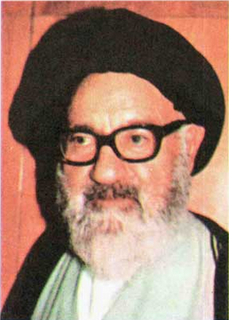
The Iranian presidential election of 1985 took place on August 16, 1985, and resulted in the re-election of the incumbent President Ali Khamenei.

Parliamentary elections were held in Iran on 13 March 1980, with a second round on 9 May. They were the first elections to the Majlis since the overthrow of the Shah, and were contested to a considerable degree on a party basis.
Parliamentary elections were held in Iran on 15 April 1984, with a second round on 17 May. The majority of seats were won by independents, whilst the Islamic Republican Party was the only party to win seats. Voter turnout was 65.1% in the first round.

Parliamentary elections were held in Iran between 30 July and 20 August 1960.
Parliamentary elections were held in Iran in 1954. Political parties were banned from contesting the election, and all 136 elected MPs were independents.
The Movement of Militant Muslims is an Iranian Islamic socialist political group led by Habibollah Payman. The group had been revolutionary and is close to Council of Nationalist-Religious Activists of Iran.
People's Party was a liberal political party in Pahlavi era Iran. It was one of two major parties in the apparent attempt to decree a two-party system by Mohammad Reza Shah, apparently opposition to the ruling New Iran Party and previously Party of Nationalists.
JAMA was an Iranian political party founded in 1964 by Kazem Sami and Habibollah Payman. In summer 1965, members of the party which maintained an opposition status were arrested and it continued activities in small circles underground.
Office for the Cooperation of the People with the President was a political entity in Iran close to then-President Abolhassan Banisadr. It was an “office” "that was created out of necessity to fulfil some, if not all, of the functions of a political party".

The Grand Coalition was the political alliance of Islamist groups contesting in the Iranian legislative election, 1980, led by the Islamic Republican Party. Various small fundamentalist groups joined the alliance.
The Eponym Group was an electoral list for the Iranian legislative election, 1980 claiming "it would choose its candidates based on merit without regard to party affiliation". Close to the Freedom Movement, the group formed a minority in the parliament with approximately 15 to 23 seats. Due to internal conflicts, the Freedom Movement did not issue a list but its members were included in the Eponym list. The list had members of Freedom Movement, JAMA and Islamic Republican Party.
Third Force was a loosely organized non-aligned political movement in Iran which advocated an independent, socialist–nationalist philosophy of development. Though not a modern party, it maintained organization within activists and press. It did not become an important party, however made an enormous impact on Iranian democracy struggle after 1953 Iranian coup d'état.
League of Socialists of the National Movement of Iran or Society of Iranian Socialists was a socialist nationalist party in Iran.
Ali Espahbodi is an Iranian economist and politician.
Mahmoud Ahmadzadeh is an Iranian engineer and politician.
Abolfazl Bazargan is an Iranian political activist and a senior member of the Freedom Movement of Iran.
Abbas Sami'i was an Iranian politician who held office as the third head of the Environmental Protection Organization.

Mohammad-Ali Angaji was an Iranian Shia cleric and politician. A loyal National Front member, he served as a member of parliament during the 17th term and ran for the 1954 election in Tehran. He was elected to the 73-seats Assembly of Experts for Constitution in 1979.
Ahmad Ghazanfarpour is an Iranian dentist and activist who served as a member of the parliament from 1980 to 1982.
Mohammad-Hassan Shamshiri, more known as Haj Hasan Shamshiri, was an Iranian bazaari restaurateur, philanthropist and civic patriotic activist.











